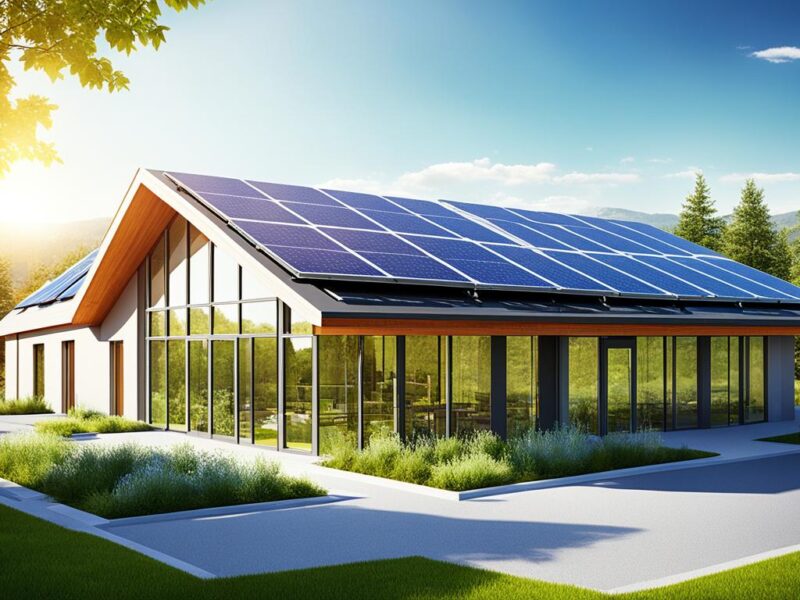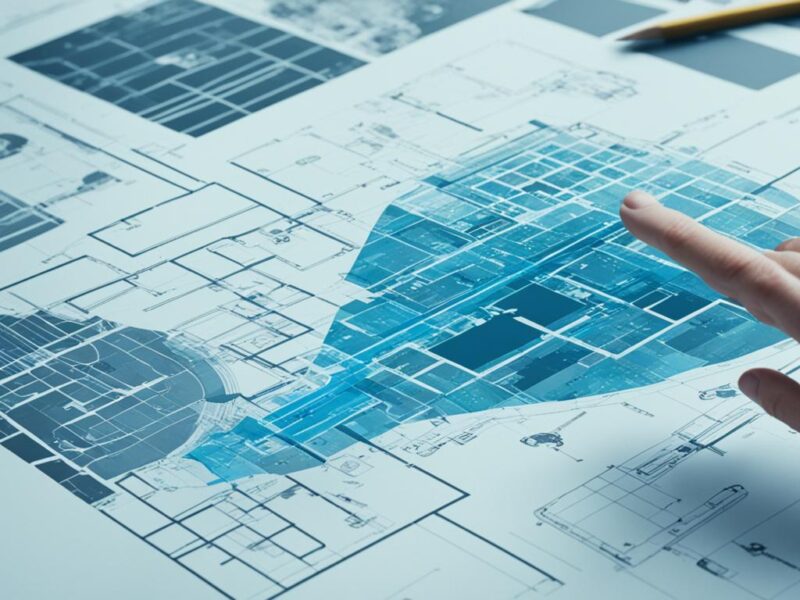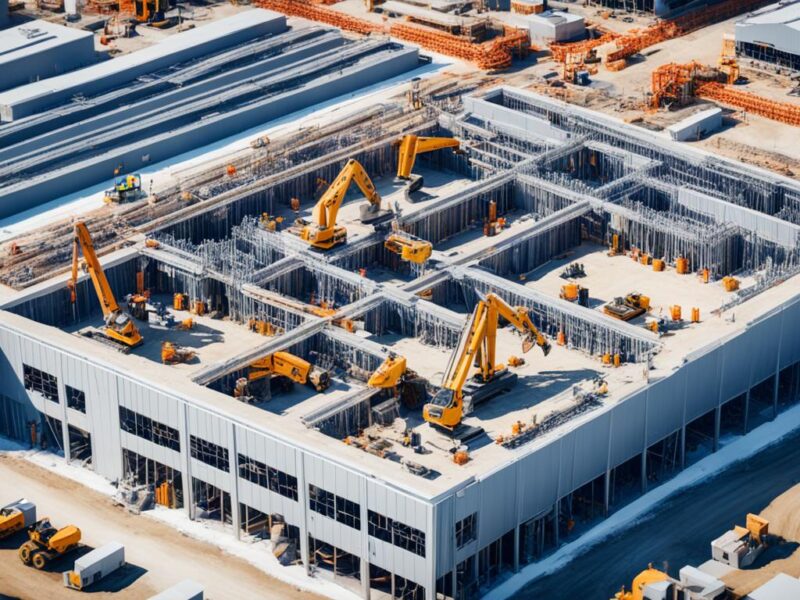
Innovative Building Solutions: Cutting-Edge Construction Materials
Did you know that the construction industry contributes to nearly 40% of global carbon emissions? Traditional building materials, such as concrete, have a significant environmental impact, fueling the need for more sustainable alternatives.
From bamboo to recycled plastics, innovative construction products are reshaping the future of the industry. These cutting-edge materials offer durability, efficiency, and a reduced carbon footprint, making them ideal for sustainable construction.
Key Takeaways:
- Cutting-edge construction materials are essential for reducing the environmental impact of the industry.
- Alternative materials like bamboo, mycelium, and recycled plastics offer sustainable and efficient solutions.
- These materials can provide durability, versatility, and novel properties for various applications in construction.
- Embracing innovative building solutions can pave the way for greener and more sustainable construction practices.
- The future of construction lies in the adoption of advanced and environmentally friendly construction materials.
Bamboo: Nature’s Versatile Wonder
Bamboo is a remarkable and sustainable resource that is increasingly being recognized as an eco-friendly alternative in the construction industry. With its numerous benefits and impressive characteristics, bamboo has quickly become a popular choice for sustainable building materials.
Renewable and Sustainable
One of the key advantages of bamboo is its renewable nature. Unlike traditional building materials that require years to grow, bamboo can reach maturity in just a few years. This fast growth rate makes it an easily replenishable resource, ensuring a sustainable supply for construction projects.
High Tensile Strength
Despite its lightweight appearance, bamboo exhibits exceptional strength-to-weight ratio, comparable to steel. This high tensile strength makes it an ideal material for structural applications, providing durability and resilience to buildings and other construction projects.
Low Environmental Impact
Bamboo has a significantly lower environmental impact compared to other building materials. Its rapid growth minimizes the need for extensive water and pesticide usage. Furthermore, bamboo releases more oxygen into the air and absorbs higher levels of carbon dioxide compared to other plants, making it an excellent natural carbon sink.
Bamboo is a sustainable resource that offers a range of benefits to both construction professionals and the environment. Its versatility and high tensile strength make it a valuable building material, while its minimal environmental impact aligns with the growing demand for green and sustainable construction practices.
With its versatility, strength, and environmental advantages, bamboo has gained recognition as a promising material for various construction applications. From flooring and walls to entire structures, bamboo is proving to be a viable and sustainable option for the future of construction.
Mycelium: The Fungal Solution
Mycelium, derived from the root structure of mushrooms, is an innovative and sustainable alternative material that is revolutionizing the construction industry. With its renewable and biodegradable properties, mycelium offers a host of benefits, making it an attractive choice for builders and architects seeking environmentally friendly solutions.
One of the key advantages of mycelium-based materials is their excellent insulation properties. The intricate network of mycelium fibers creates a natural barrier, effectively reducing heat transfer and minimizing energy consumption for heating and cooling. This not only helps to create energy-efficient buildings but also contributes to cost savings in the long run.
Moreover, mycelium exhibits innate fire-resistant properties, making it an ideal material for enhancing the safety and durability of structures. Studies have shown that mycelium can withstand high temperatures and flames, providing an added layer of protection in the event of a fire. By incorporating mycelium-based materials, buildings can be designed to meet stringent fire safety standards without compromising on sustainability.
Furthermore, mycelium offers versatility in its applications across various construction elements. It can be used for insulation panels, acoustic materials, and even as a sustainable alternative to traditional bricks. Mycelium-based products are lightweight, yet structurally robust, making them suitable for a wide range of architectural designs.
As an organic and environmentally friendly material, mycelium aligns with the global movement towards sustainable building practices. Its renewable nature, excellent insulation properties, and fire resistance make it an appealing option for eco-conscious builders. The adoption of mycelium-based materials in construction not only reduces reliance on non-renewable resources but also contributes to the overall reduction of carbon emissions in the industry.
By embracing mycelium, the construction industry can pave the way for a greener and more sustainable future, where renewable and biodegradable materials play a crucial role in mitigating environmental impact. As the demand for innovative, eco-friendly solutions continues to grow, mycelium stands out as a fungal solution that combines functionality, sustainability, and resilience.

Advantages of Mycelium in Construction:
| Advantages | Description |
|---|---|
| Renewable and Biodegradable | Mycelium can be grown and harvested in a lab, making it a sustainable alternative to non-renewable materials. |
| Excellent Insulation Properties | The natural structure of mycelium provides exceptional thermal insulation, reducing energy consumption. |
| Fire-Resistant | Mycelium exhibits innate fire resistance, enhancing the safety and durability of structures. |
| Versatility | Mycelium can be used in various construction elements such as insulation panels, acoustic materials, and sustainable bricks. |
| Environmental Sustainability | By using mycelium-based materials, the construction industry supports the global movement toward sustainable building practices and reduces carbon emissions. |
Recycled Plastics: Turning Trash into Treasure
Plastic waste is a pressing environmental concern that has far-reaching consequences. However, thanks to advancements in technology, we now have the means to transform this waste into valuable and sustainable building materials. By diverting plastic from landfills and repurposing it for construction, we can significantly reduce our carbon footprint and contribute to a more sustainable future.
Recycled plastic materials offer remarkable durability and versatility, making them an attractive option for various construction applications. Through innovative engineering, recycled plastics can be engineered to possess strength and resilience comparable to traditional building materials. This not only enables us to build sturdy structures but also ensures that we make the most of our existing resources.
One of the key advantages of using recycled plastics in construction is the significant reduction in the environmental impact compared to conventional manufacturing processes. By repurposing plastic waste, we eliminate the need for energy-intensive production methods and reduce carbon emissions. This sustainable approach contributes to the preservation of our natural resources and helps create a greener and healthier planet.
Benefits of Recycled Plastics in Construction:
- Reduced carbon footprint by repurposing plastic waste
- Durability comparable to traditional building materials
- Versatility in various construction applications
The construction industry is increasingly embracing the use of recycled plastics for a wide range of applications. Here is a table highlighting some of the common uses of recycled plastic materials in construction:
| Application | Description |
|---|---|
| Roofing Tiles | Recycled plastic roofing tiles offer excellent durability and weather resistance, providing a sustainable alternative to traditional roofing materials. |
| Insulation Boards | Recycled plastic insulation boards provide effective thermal insulation and help reduce energy consumption. |
| Outdoor Furniture | Recycled plastic is widely used in the production of outdoor furniture, offering durability and resistance to weather elements. |
| Paving Blocks | Recycled plastic paving blocks are a sustainable choice for sidewalks, driveways, and pathways, providing strength and durability. |
Note: The table above showcases just a few examples of the broad range of applications for recycled plastic materials in the construction industry.
By harnessing the potential of recycled plastics, we can contribute to the development of a circular economy and reduce our dependence on finite resources. Implementing sustainable construction practices that prioritize the use of recycled materials is not only beneficial for the environment but also fosters a more resilient and innovative industry as a whole.
Next, we will explore another exciting alternative building material that has garnered attention in recent years: social-media-platform. Keep reading to discover the possibilities it holds for the future of construction.
Conclusion
As the construction industry seeks sustainable solutions, the demand for cutting-edge construction materials is on the rise. Bamboo, mycelium, and recycled plastics are emerging as promising alternatives and offer exciting prospects for the future of construction. These sustainable building materials not only contribute to a greener environment but also offer durability and versatility.
Bamboo, with its renewable nature and high tensile strength, presents itself as a versatile wonder in construction. It can be used for various applications such as flooring, walls, and structures, providing a sustainable and eco-friendly solution to traditional building materials.
Mycelium, derived from the root structure of mushrooms, offers excellent insulation properties and remarkable fire resistance. Being renewable and biodegradable, mycelium-based materials provide a safe and reliable option for insulation, panels, and bricks in construction.
Recycled plastics, on the other hand, are turning trash into treasure. By repurposing plastic waste, the construction industry reduces its carbon footprint and minimizes environmental impact. These recycled plastic materials can be engineered to possess strength and durability similar to conventional building materials, making them suitable for roofing tiles, insulation boards, and other applications.
By embracing these cutting-edge construction materials, the future of construction can be shaped towards sustainability. The use of renewable resources, such as bamboo and mycelium, along with the smart utilization of recycled plastics, will contribute to a greener and more sustainable construction sector. As the industry continues to innovate, the integration of these green building materials will pave the way for an innovative and environmentally conscious future of construction.
FAQ
What are cutting-edge construction materials?
Cutting-edge construction materials refer to innovative and advanced building materials that push the boundaries of traditional construction methods. These materials often incorporate the latest construction technology and offer unique features such as improved durability, sustainability, and energy efficiency.
Why is bamboo considered a sustainable resource for construction?
Bamboo is considered a sustainable resource for construction because it is renewable and grows much faster than traditional trees. It can be harvested in just a few years, making it an ideal alternative to slow-growing wood materials. Bamboo also has a low environmental impact, requires minimal water and pesticides, and offers a high tensile strength comparable to steel.
What are the advantages of using mycelium-based materials in construction?
Mycelium-based materials offer several advantages in construction. They are renewable and biodegradable, as they can be grown and harvested in a lab. These materials also possess excellent insulation properties, reducing heating and cooling costs. Additionally, mycelium has innate fire-resistant properties, providing a safe and reliable building material for various construction applications.
How does using recycled plastics benefit the construction industry?
Using recycled plastics in construction offers numerous benefits. By repurposing plastic waste, it helps reduce the amount of waste going to landfills, contributing to a cleaner environment. Additionally, using recycled plastics in construction lowers the overall carbon footprint by minimizing the energy and resources required for traditional manufacturing processes. These materials can be engineered to possess strength and durability similar to traditional building materials, making them a viable and sustainable alternative.
How can embracing cutting-edge construction materials shape the future of construction?
Embracing cutting-edge construction materials can shape the future of construction by promoting sustainability and innovation. These materials offer solutions to the environmental challenges faced by the industry, such as reducing carbon emissions and minimizing waste. By adopting advanced building materials, the construction sector can lead the way towards a greener and more sustainable future.
Source Links
- https://www.polygongroup.com/en-US/blog/cutting-edge-construction-materials-build-a-new-look-for-the-future2/
- https://utilitiesone.com/reinventing-construction-exploring-cutting-edge-building-materials
- https://home.howstuffworks.com/home-improvement/construction/green/10-cutting-edge-building-materials.htm







